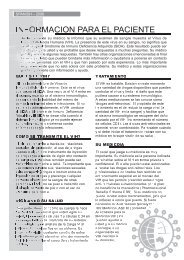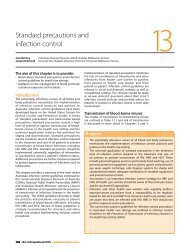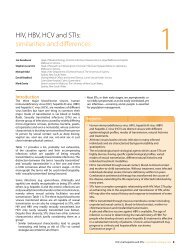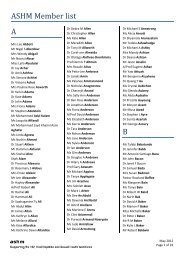B Positive – all you wanted to know about - ASHM
B Positive – all you wanted to know about - ASHM
B Positive – all you wanted to know about - ASHM
Create successful ePaper yourself
Turn your PDF publications into a flip-book with our unique Google optimized e-Paper software.
Health Records and Information Privacy Act 2002 (NSW) .....9<br />
‘healthy carrier’.............................................................................................41<br />
Hepadnaviridae.......................................................................................... 4<br />
hepatic decompensation.....................................10, 51, 6 , 65<strong>–</strong>6<br />
hepatic encephalopathy.....................................................11, 5 , 54<br />
hepatic fibrosis...................................................................................................<br />
...............9<strong>–</strong>11, 31, 33<strong>–</strong>5, 37<strong>–</strong>8, 4 , 44, 53, 59<strong>–</strong>60, 6 , 65, 96<strong>–</strong>8<br />
hepatic synthetic function..................................................................53<br />
hepatitis A...............................................................................37, 48, 5 , 77<br />
Hepatitis Australia...................................................................................105<br />
Hepatitis B immunoglobulin (HBIG) see HBIG<br />
hepatitis C.............................................................................................17<strong>–</strong>18,<br />
35, 47, 51, 53<strong>–</strong>4, 63, 65<strong>–</strong>6, 68, 78<strong>–</strong>9, 8 <strong>–</strong>3, 85<strong>–</strong>7, 104<strong>–</strong>5<br />
• see also HBV-HCV coinfection<br />
hepatitis D..........................................................43<strong>–</strong>4, 5 , 54, 66, 78<strong>–</strong>9<br />
hepa<strong>to</strong>cellular carcinoma (HCC.............................................69<strong>–</strong>7<br />
• chronic hepatitis B.....................................................................51<br />
• cirrhosis.....................................................................................44, 70<br />
• epidemiology...................................................................................11<br />
• ethnicity...........................................................................15, 18, 69<br />
• HBV DNA level.............................................................31, 44, 53<br />
• high-risk communities..................................................69<strong>–</strong>70<br />
• incidence........................................................................14, 69<strong>–</strong>70<br />
• Indigenous Australians..........................................................16<br />
• lamivudine....................................................................................60<br />
• mortality...................................................................................14, 69<br />
• prediction of development....3 <strong>–</strong>3, 43<strong>–</strong>4, 53, 65, 69<br />
• prevention................................................................................71<strong>–</strong><br />
• risk fac<strong>to</strong>rs.......................................................................................44<br />
• screening.................................................................55, 68, 70, 7<br />
• treatment options..............................................................11, 71<br />
• vaccination.....................................................................................46<br />
hepa<strong>to</strong>cytes............................................................ 4<strong>–</strong>5, 43, 54, 80, 98<br />
hepa<strong>to</strong>ma see liver cancer<br />
high-risk behaviours.......................................................17<strong>–</strong>19, 40, 47<br />
• see also exposure-prone procedures<br />
high-risk communities.......................6, 9, 14<strong>–</strong>18, 35, 40, 47, 7<br />
highly active antiretroviral therapy (HAART) see cART<br />
His<strong>to</strong>logical Activity Index (HAI)......................................................34<br />
his<strong>to</strong>logy....................................................................................4 <strong>–</strong>3, 60, 97<br />
HIV......................................................................................................... 6<strong>–</strong>9, 35,<br />
47, 55, 61, 66, 75<strong>–</strong>6, 80, 8 <strong>–</strong>3, 85<strong>–</strong>7, 89<strong>–</strong>90, 104<br />
• HBV-HIV coinfection ....................... 7, 44, 5 , 63, 78<strong>–</strong>9<br />
HIV Observational Database............................................................78<br />
Hong Kong immigrants........................................................................15<br />
household contacts...................................................................................<br />
..............................35, 40, 46<strong>–</strong>7, 5 , 75, 77, 83, 85, 10 , 104<strong>–</strong>5<br />
i<br />
immunosuppression..............................35, 43, 47, 49, 54, 75, 80<br />
‘inactive carrier’......................................................................................41<strong>–</strong><br />
incubation...............................................................................................31, 41<br />
Indigenous Australians<br />
• high risk group ..........................................................18<strong>–</strong>19, 40<br />
• liver cancer ...........................................................................15<strong>–</strong>16<br />
• prevalence ............................................................14<strong>–</strong>16, 35, 47<br />
• vaccination .................................................................. 15, 47, 50<br />
Infanrix HepB.................................................................................................48<br />
Infanrix Hexa..................................................................................................48<br />
Infanrix Penta................................................................................................48<br />
infant vaccination programs......9, 18, 46<strong>–</strong>9, 71, 76<strong>–</strong>7, 85, 104<br />
infection control...................................................................................8 <strong>–</strong>9<br />
Infection Control Guidelines for the Prevention of<br />
Transmission of Infectious Diseases in the Health Care<br />
Setting.................................................................................................8 <strong>–</strong>4, 87<br />
informed consent......................................................................36, 90, 93<br />
injecting drug users<br />
• disease pattern............................................................................17<br />
• HBV-HCV coinfection......................................................17, 79<br />
• HBV-HDV coinfection.............................................................79<br />
• HBV transmission.........................................40, 46, 10 , 104<br />
• prevalence............................................................13<strong>–</strong>14, 17<strong>–</strong>18<br />
• vaccination..................................................................47, 85, 104<br />
intellectu<strong>all</strong>y disabled people...........................................................47<br />
interferon based-therapy...........................................................................<br />
.......................10, 33, 55, 57, 59<strong>–</strong>63, 65<strong>–</strong>6, 7 , 77<strong>–</strong>80, 97<strong>–</strong>8, 103<br />
Ishak modified HAI...................................................................................34<br />
J<br />
jaundice.........................................................................11, 41, 53, 66, 10<br />
K<br />
kava................................................................................................................98<strong>–</strong>9<br />
kurorinone................................................................................................97<strong>–</strong>9<br />
L<br />
lamivudine (LMV)...........................................................................................<br />
.......................10, 5, 7<strong>–</strong>9, 44, 55, 57, 59<strong>–</strong>6 , 76<strong>–</strong>80, 97<strong>–</strong>8, 103<br />
Larrea tridenta (chaparral)...........................................................96, 98<br />
lifestyle issues.............................................................................................103<br />
liver biopsy.................................9, 33<strong>–</strong>5, 43, 53, 55, 57<strong>–</strong>9, 70, 103<br />
• liver cancer see hepa<strong>to</strong>cellular carcinoma (HCC)<br />
liver enzymes................................................................................................53<br />
liver function tests...............................................................4 , 53<strong>–</strong>4, 6<br />
b <strong>Positive</strong> <strong>–</strong> <strong>all</strong> <strong>you</strong> <strong>wanted</strong> <strong>to</strong> <strong>know</strong> <strong>about</strong> hepatitis b: a guide for primary care providers 1 1






